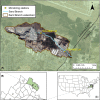A Novel Approach to Developing Thresholds for Total Dissolved Solids Using Standardized and Experimental Toxicity Test Methods
- PMID: 35975448
- PMCID: PMC9828499
- DOI: 10.1002/etc.5466
A Novel Approach to Developing Thresholds for Total Dissolved Solids Using Standardized and Experimental Toxicity Test Methods
Abstract
The increasing salinization of freshwater streams from anthropogenic land uses and activities is a growing global environmental problem. Increases in individual ions (such as sodium or chloride) and combined measures such as total dissolved solids (TDS) threaten drinking water supplies, agricultural and economic interests, and the ecological health of freshwater streams. Because the toxicity of high ionic strength waters depends on the specific ion composition, few water quality standards exist to protect freshwater streams from salinization. In the present study, we used a novel approach to develop site-specific and ecologically relevant TDS thresholds for the protection of aquatic life. The first step of the approach was to characterize the ion composition of the waterbody or region of interest and prepare artificial samples to match that composition. Using a combination of standardized toxicity test species and more ecologically relevant field-collected species, toxicity tests were then conducted on these artificial samples prepared at a range of TDS concentrations. The advantage of this approach is that water quality criteria can be developed for easy-to-measure generalized parameters such as TDS while ensuring that the criteria are protective of instream aquatic life and account for the complex interactions of the various ions contributing to salinization. We tested this approach in Sand Branch, Loudoun County, Virginia, USA, where salinization from hard rock mining and urban runoff has impaired aquatic life. Acute and chronic TDS thresholds of 938 and 463 mg/L, respectively, were developed in this stream and used for total maximum daily load development in the watershed. The approach provides a potential model for establishing protective thresholds for other waterbodies impacted by salinization. Environ Toxicol Chem 2022;41:2782-2796. © 2022 The Authors. Environmental Toxicology and Chemistry published by Wiley Periodicals LLC on behalf of SETAC.
Keywords: Freshwater salinization; freshwater toxicology; total dissolved solids; total maximum daily loads (TMDLs); water quality criteria.
© 2022 The Authors. Environmental Toxicology and Chemistry published by Wiley Periodicals LLC on behalf of SETAC.
Figures






Similar articles
-
Assessing the Toxicity of Sea Salt to Early Life Stages of Freshwater Mussels: Implications for Sea Level Rise in Coastal Rivers.Environ Toxicol Chem. 2023 Nov;42(11):2478-2489. doi: 10.1002/etc.5731. Epub 2023 Sep 20. Environ Toxicol Chem. 2023. PMID: 37727898
-
Influence of water hardness and sulfate on the acute toxicity of chloride to sensitive freshwater invertebrates.Environ Toxicol Chem. 2011 Apr;30(4):930-8. doi: 10.1002/etc.454. Epub 2011 Feb 11. Environ Toxicol Chem. 2011. PMID: 21191883
-
Evaluation of ionic contribution to the toxicity of a coal-mine effluent using Ceriodaphnia dubia.Arch Environ Contam Toxicol. 2005 Aug;49(2):155-62. doi: 10.1007/s00244-004-0034-z. Epub 2005 Jul 6. Arch Environ Contam Toxicol. 2005. PMID: 16001150
-
Lost in translation: the German literature on freshwater salinization.Philos Trans R Soc Lond B Biol Sci. 2018 Dec 3;374(1764):20180007. doi: 10.1098/rstb.2018.0007. Philos Trans R Soc Lond B Biol Sci. 2018. PMID: 30509909 Free PMC article. Review.
-
Updating the Chronic Freshwater Ecotoxicity Database and Biotic Ligand Model for Nickel for Regulatory Applications in Europe.Environ Toxicol Chem. 2023 Mar;42(3):566-580. doi: 10.1002/etc.5561. Epub 2023 Feb 13. Environ Toxicol Chem. 2023. PMID: 36650904 Review.
Cited by
-
Ion Clusters Reveal the Sources, Impacts, and Drivers of Freshwater Salinization.Environ Sci Technol. 2025 Jul 15;59(27):14053-14062. doi: 10.1021/acs.est.5c04512. Epub 2025 Jun 16. Environ Sci Technol. 2025. PMID: 40521754 Free PMC article.
-
Using Single-Species and Whole Community Stream Mesocosm Exposures for Identifying Major Ion Effects in Doses Mimicking Resource Extraction Wastewaters.Water (Basel). 2023 Jan 6;15(2):1-26. doi: 10.3390/w15020249. Water (Basel). 2023. PMID: 38269364 Free PMC article.
-
Salty chemical cocktails as water quality signatures: Longitudinal trends and breakpoints along different U.S. streams.Sci Total Environ. 2024 Jun 20;930:172777. doi: 10.1016/j.scitotenv.2024.172777. Epub 2024 Apr 25. Sci Total Environ. 2024. PMID: 38670384 Free PMC article.
-
Cytotoxicity of water supply in a Palestinian refugee camp and a Syrian informal tented settlement in Lebanon.PLoS One. 2024 Jan 2;19(1):e0294679. doi: 10.1371/journal.pone.0294679. eCollection 2024. PLoS One. 2024. PMID: 38165866 Free PMC article.
References
-
- American Public Health Association, American Water Works Association, World Environment Federation . (1998). Standard methods for the examination of water and wastewater (20th ed.). American Public Health Association.
-
- Barbour, M. , Gerritsen, J. , Snyder, B. , & Stribling, J. (1999). Rapid bioassessment protocols for use in streams and rivers; periphyton, benthic macroinvertebrates, and fish (EPA841‐b‐99‐002). US Environmental Protection Agency, Office of Water.
-
- Burton, J. , & Gerritsen, J. (2003). A stream condition index for Virginia non‐coastal streams. Tetra Tech.
-
- Cañedo‐Argüelles, M. , Hawkins, C. P. , Kefford, B. J. , Schäfer, R. B. , Dyack, B. J. , Brucet, S. , & Timpano, A. J. (2016). Saving freshwater from salts. Science, 351(6276), 914–916. - PubMed
-
- Cañedo‐Argüelles, M. , Kefford, B. J. , Piscart, C. , Prat, N. , Schäfer, R. B. , & Schulz, C. J. (2013). Salinisation of rivers: An urgent ecological issue. Environmental Pollution, 173, 157–167. - PubMed
Publication types
MeSH terms
Substances
LinkOut - more resources
Full Text Sources
Medical

